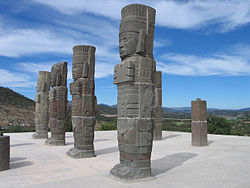The History of the Native Peoples of the Americas/Mesoamerican Cultures/Toltecs
| A reader requests expansion of this page to include more material. You can help by adding new material (learn how) or ask for assistance in the reading room. |
The word Toltec in Mesoamerican studies has been used in different ways by different scholars to refer to actual populations and polities of pre-Columbian central Mexico or to the mythical ancestors mentioned in the mythical/historical narratives of the Aztecs. It is an ongoing debate whether the Toltecs can be understood to have formed an actual ethnic group at any point in Mesoamerican history or if they are mostly or only a product of Aztec myth.


The scholars who have understood the Toltecs to have been an actual ethnic group often connect them to the archeological site of Tula, Hidalgo which is then supposed to have been the Tollan of Aztec myth.[1] This tradition assumes the "Toltec empire" to have dominated much of central Mexico between the 10th and 12th century AD. Other Mexican cities such as Teotihuacán[2] have also been proposed to have been the historical Tollan "Place of Reeds", the city from which the name Tolteca "inhabitant of Tollan" is derived in the Nahuatl language. The term Toltec has also been associated with the arrival of certain Central Mexican cultural traits into the Mayan sphere of dominance that took place in the late classic and early postclassic periods, and the Postclassic Mayan civilizations of Chichén Itzá, Mayapán and the Guatemalan highlands have been referred to as "toltecized" or "mexicanized" Mayas. For example the striking similarities between the city of Tula, Hidalgo and Chichen Itza have often been cited as direct evidence for Toltec dominance of the Postclassic Maya.
This line of scholarship was popular in the first half of the twentieth century but has largely been abandoned in recent decades in favour of a more critical and interpretive approach to the historicity of the Aztec mythical accounts, that applies a different understanding of the word Toltec.[3]
This tradition has interpreted the concept of Toltecs largely as an Aztec or generally Mesoamerican mythical and philosophical construct that has served to symbolize the civilizedness and might of several different cultures of the Mesoamerican chronology|Mesoamerican Postclassic period. Among the Nahuan peoples the word "Tolteca" was synonymous with artist, artisan or wise man, and "toltecayotl" "Toltecness" meant art, culture and civilization and urbanism - and was seen as the opposite of "Chichimecayotl" "chichimecness" which symbolized the savage, nomadic state of peoples who had not yet become urbanized. This interpretation argues that any large urban center in Mesoamerica could be referred to as "Tollan" and its inhabitants as Toltecs - and that any ruling lineage in postclassic Mesoamerica would strengthen their claims to power by claiming Toltec ancestry. Often Mesoamerican migration accounts state that Tollan was ruled by Quetzalcoatl (or Kukulcan in Yucatec Maya and Gukumatz K'iche') a godlike mythical figure who was later sent into exile from Tollan and went on to found a new city somewhere else in Mesoamerica. Such claims of Toltec ancestry and a ruling dynasty founded by Quetzalcoatl have been made by such diverse civilizations as the Aztec, the Quiché and the Itza' Mayas. While the sceptical tradition does not deny that cultural traits of a seemingly central Mexican origin have diffused into a larger area of Mesoamerica they tend to ascribe this to the dominance of Teotihuacán in the Classic period and the general diffusion of Cultural traits within the region. Recent scholarship thus do not see Tula, Hidalgo as a "Toltec" site but rather tries to find clues of the ethnicity of the people who built it. Lately it has been suggested that they were in fact Huastecs.
The historical tradition of scholarship tries to take the Mesoamerican ethnohistorical accounts at face value and discern between a historical Toltec civilization and the way it has become integrated in Postclassic Mesoamerican mythology. It also tries to discern between the deity Quetzalcoatl and the Toltec ruler by the same name. In the view of the sceptic tradition such a distinction is impossible or extremely difficult to make exactly because the Mesoamerican peoples themselves did not discern between historical fact and mythical and metaphorical representations of these. The early tradition read the ethnohistorical sources and tried to find confirmation of these stories through archeology, but the sceptical tradition does not accept this method as fruitful because basing the understanding of Mesoamerican history on mythical accounts that were not meant to reflect actual history may lead to biased interpretations of archeological findings. Instead they prefer to let archeology speak for itself and interpret the ethnohistorical sources in a way that corroborates rather than defines the archeological findings.
During the late twentieth century, the word Toltec acquired a new meaning within New Age circles, largely because of the use of the word by Carlos Castaneda and others inspired by him such as Victor Sanchez. For the concept Toltec as used in the writings of Carlos Castaneda, see: Toltec (Castaneda).